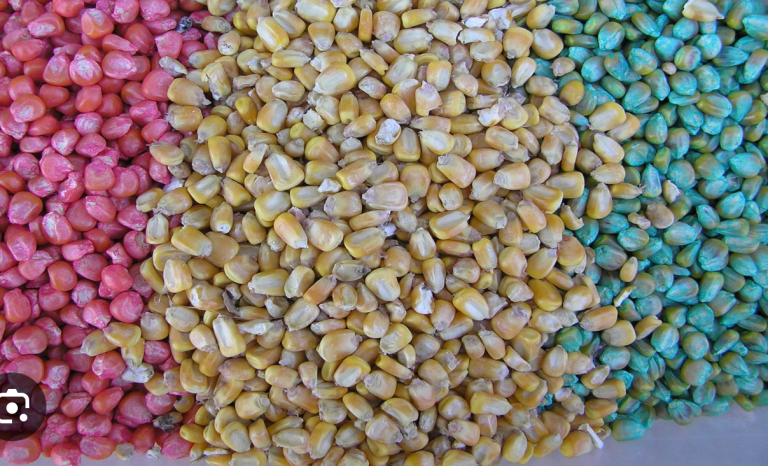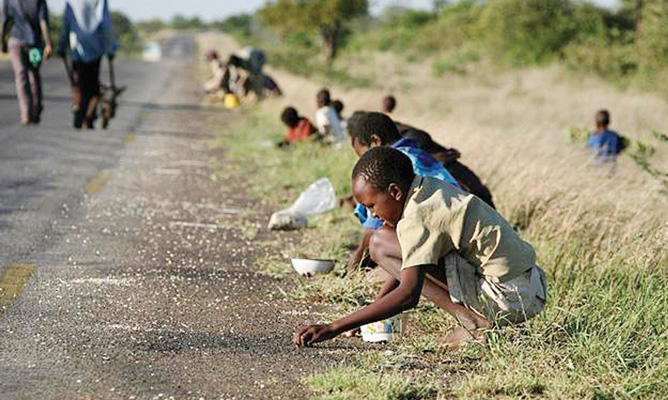By Tatenda Chitagu
MASVINGO, ZIMBABWE-There is a popular vernacular saying that goes; ‘Kange mbeu kurima kwakona.‘
Loosely translated, it means; ‘Better eat the seeds since farming has failed.’
This saying turned out to be true for a hunger-stricken family from the arid Mwenezi district of southern Masvingo province that consumed a meal prepared from treated maize seeds, as food shortages worsen during the lean season in Zimbabwe.
Sadly, five family members died from eating the treated seeds, the police confirmed.
“I can confirm the death of five people in Mwenezi after they ate food using mealie meal prepared after they had washed treated maize seed,” said national police spokesperson Commissioner Paul Nyathi.
“Investigations are ongoing, and full details will be released in due course,” Nyathi said.
The names of the deceased-from Dombodema Village in Sovelele under Chief Mazetese-were not availed by the time of going to print.

Treated maize seed (picture sourced online/ZimEye)
Mwenezi district, domiciled in agro-ecological region five, is hot and dry and receives low rainfall that leads to recurrent droughts.
The tragic deaths come after government declared that no one will die of hunger.
“No Zimbabwean must succumb or die from hunger,” President Emmerson Mnangagwa is on record as saying.
Masvingo Provincial Affairs and Devolution Minister Ezra Chadzamira reiterated the same call at launch of the Lean Season Assistance (LSA) Program by the World Food Program (WFP) on 12 December last year in Chivi district in the same Masvingo province.
“No place (will be left behind) and no one will die of hunger,” Chadzamira said.
Not an isolated incident
The Mwenezi incident is just but a tip of the iceberg, according to other local villagers.
“Many from this area had resorted to converting the seeds into mealie meal because of the food shortages we are facing, as well as another impending drought in the horizon,” said Tiko Chauke, another villager from the area, in a telephone interview.
“We first wash the maize seeds to remove the coating chemicals, dry them and head to the grinding meal. It is better than plant the seed and the crop wilts. This family was just unlucky in that maybe they did not wash the seeds thoroughly to remove the chemical, but almost everyone is doing this here,” he added.
And the Mwenezi villagers can be forgiven for doing that.
As the country received delayed erratic rains this cropping season, most farmers from Masvingo had not planted, or are still planting their first crops.
While there is a current wet spell since a fortnight ago, it came after most of the crops had already wilted due to moisture stress from a prolonged dry patch.
Government also announced that the maize planting period had lapsed and any additional cropping will be fruitless.
Last farming season, Zimbabwe faced an El-Nino induced drought that left an estimated 7.6 million people in need of food aid, according to the WFP.
President Emmerson Mnangagwa declared the 2023-2024 agricultural season a state of national disaster following the drought that led to serious food shortages.
The hunger led to an increase in malnutrition cases, according to UNICEF.
““As of May 31, 2024, a total of 983 560 children aged 6 to 59 months were screened for wasting and 4 721 found to be malnourished were treated,” UNICEF said in its humanitarian report released in July last year.
“Due to the El Niño-induced drought, a total of 7,6 million people including 3,5 million children urgently need life-saving and life-sustaining humanitarian assistance and protection support, as well as livelihood support, to recover from their losses, rebuild resilience and access to basic services,” adds the report.
Mnangagwa appealed for $3 billion in aid to help cover the food deficit.
WFP warned more people will be in need of food aid before the next harvest.
“Between now and March 2025, WFP, aims to assist close to one million people across the country with food assistance. More resources and collaborations are needed to reach those still in need,” said WFP representative and country director Barbara Clemens at the launch of the LSA program.
The Mwenezi tragic deaths mirror the dire food shortages that Zimbabweans are facing.
In another incident last week, a 42 year-old Masvingo man was murdered for allegedly stealing a pot of sadza, the staple corn paste, and chicken relish, the police confirmed.
“The ZRP confirms the arrest of Makneme Chikutuva (41) in connection with a murder case which occurred in Midzi village in Masvingo on January 11 in which Maxwell Manjonjo (42) died,” said Commissioner Nyathi.
He added; “The suspect allegedly assaulted Manjonjo with leather straps from an ox yoke all over his body after accusing him of stealing a pot containing sadza and chicken.”
Government has agreed that the hunger crisis in the country had reached pandemic levels.
“I must admit that the El Nino-induced drought has negatively impacted our communities, threatening lives and livelihoods,” said Minister Chadzamira at the LSA program launch.
He added that government is providing cereals to the Chivi villagers to alleviate food shortages while other stakeholders like Non-Governmental Organisations (NGOs) and other nations like Russia are also chipping in.
Russia provided, through the WFP, oil and pulses for more than 123 000 people in Chivi, another arid district bordering Mwenezi.
The Ministry of Public Service, Labour and Social Welfare said it is giving 7,5 kgs of grain per month to each food insecure person in Masvingo province.
“During this peak hunger period, there are approximately 969,470 food insecure people in Masvingo province, who require over 21,100 metric tonnes of grain per month. Each receives 7,5 kgs of grain per month,” The Ministry said in written responses to HuMFOZ.
The Ministry said it is set to assist food insecure urban households as well in the province.
“Under the urban Cash for Cereal Program, Masvingo province has a targeted food insecure population of 37,833, and registration of beneficiaries is being finalized and once resources become available, payments will be made at US$8 per person, payable at the prevailing bank rate,” adds the statement.
**Banner Image: In this file picture, children pick up maize grains that dropped from a truck along a major highway in Zimbabwe (Picture sourced online/Newsday Zimbabwe)


4 responses to “Zimbabwe’s hunger crisis turns fatal”
You amplified the story very well, thank you.
Great follow up and amplification of the story
Thanks for breaking the story. You scooped!
Good analytical story Mr Chitagu